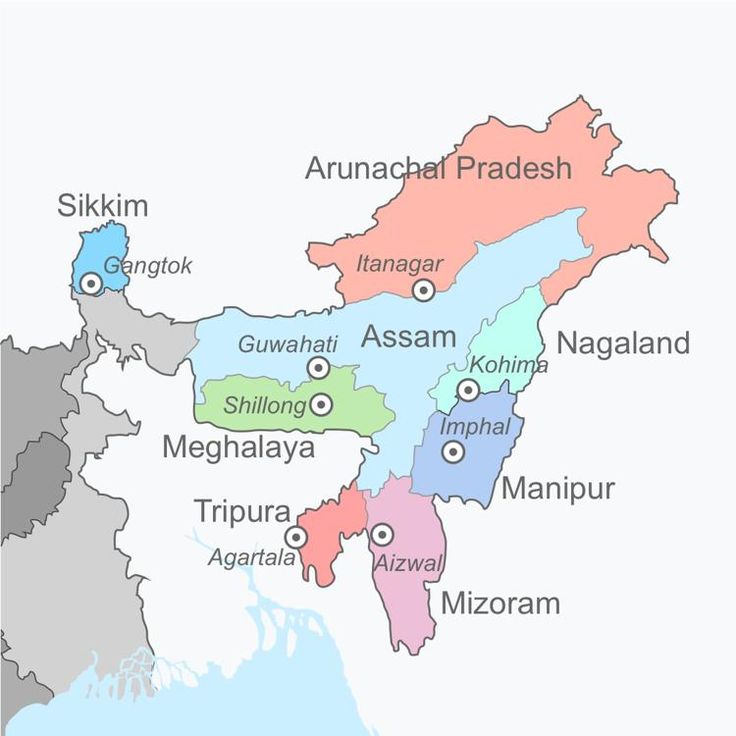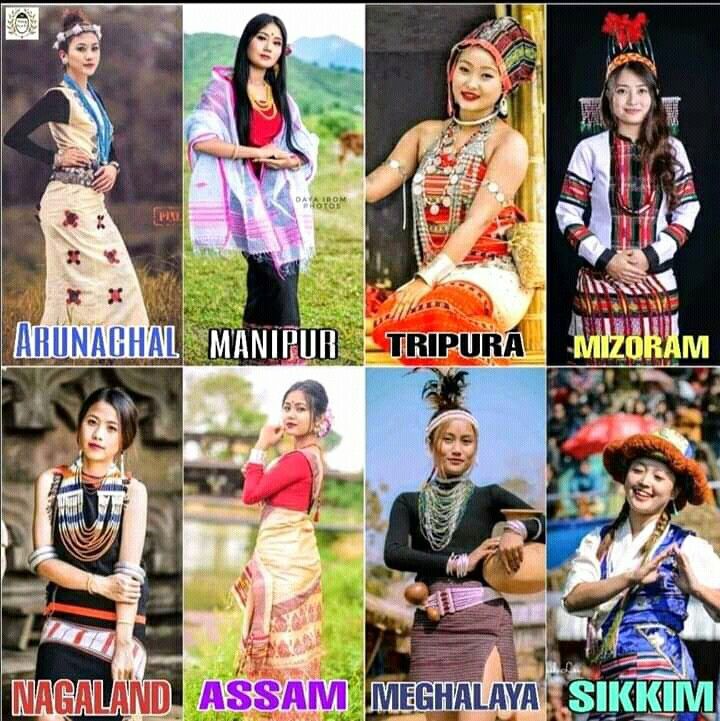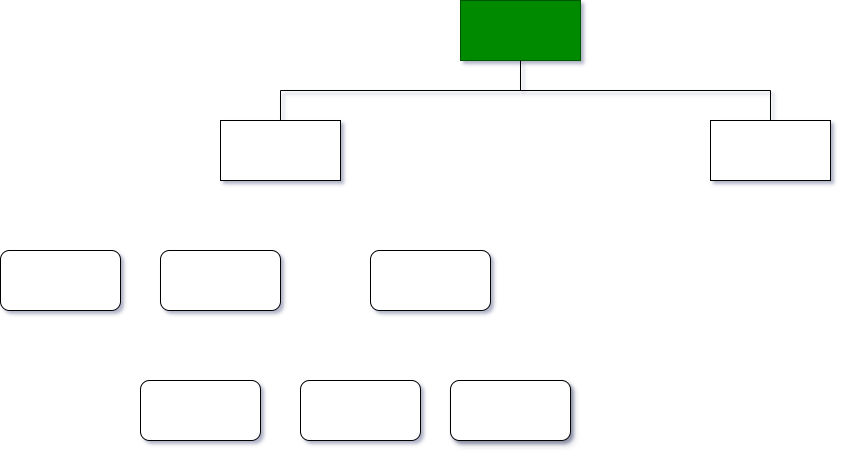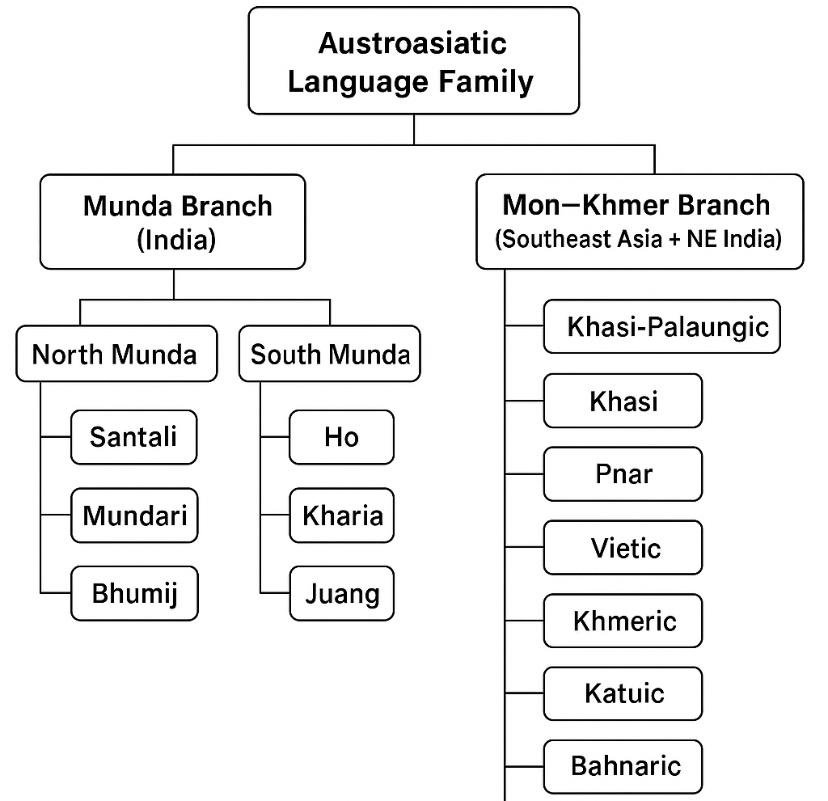e?
The Five Linguistic Roots of Northeast India
Northeast India, one of the most culturally rich and geographically distinct regions of the country, is home to a remarkable linguistic diversity. Despite covering only about 8% of India’s land area, this region boasts five major linguistic families, making it one of the most language-rich zones in all of South Asia. These linguistic groups are:
1. Tibeto-Burman
2. Austroasiatic
3. Tai-Kadai
4. Indo-Aryan
5. Isolates/Unclassified languages
Each group represents not just a way of speaking but a deep-rooted cultural identity tied to specific communities, histories, and geographies. These languages are spoken across the eight states of the Northeast — Assam, Arunachal Pradesh, Meghalaya, Manipur, Mizoram, Nagaland, Tripura, and Sikkim


Tibeto-Burman languages
Tibeto-Burman languages are a major branch of the Sino-Tibetan language family, spoken across parts of Northeast India, Tibet, Nepal, Bhutan, Myanmar (Burma), and Southwest China. They include over 400 languages and are spoken by more than 60 million people. In Northeast India, Tibeto-Burman is the dominant linguistic family among tribal communities, especially in hill regions. In Northeast India, there are approximately 90 to 100 distinct Tibeto-Burman languages spoken across the eight states — many of them by small tribal communities, and some with fewer than 10,000 speakers.

Austroasiatic Language Group
The Austroasiatic (AA) language family is one of the oldest and most widespread language families in South and Southeast Asia. The name Austroasiatic means “South Asia,” but the family is spread across India, Bangladesh, Southeast Asia (like Vietnam, Cambodia, Laos), and parts of Southern China .Austroasiatic language family has two main branches

Most Austroasiatic languages in India belong to the Munda branch, spoken mainly by tribal communities in Central and Eastern India—such as the Santals, Mundas, Hos, and Kharias—in states like Jharkhand, Odisha, West Bengal, Chhattisgarh, and Bihar. These languages, like Santali and Mundari, are not tonal and have little connection to Southeast Asia. On the other hand, Northeast India—especially Meghalaya—is home to the Mon–Khmer branch of Austroasiatic, which includes Khasi, Pnar, and War Khasi. These languages are spoken by the Khasi-Jaintia communities and are closely related to Southeast Asian languages like Khmer and Vietnamese. This makes Northeast India the only region in the country where Mon–Khmer languages are native, setting it apart linguistically and culturally from the Munda-speaking regions of mainland India.
Tai kadai
The Tai-Kadai language family, believed to have originated in southern China, now extends through Thailand, Laos, Myanmar, and into the northeastern corner of India. These communities migrated into the region during different historical periods, bringing with them Theravada Buddhism, rice cultivation techniques, and rich oral traditions. The Tai-Kadai groups found in Northeast India include the Tai Ahom, Tai Khamti, Tai Phake, Tai Aiton, Tai Turung, and Tai Khamyang.
Among these, the Tai Ahoms are the most populous. Their ancestors founded the Ahom Kingdom in the 13th century, which ruled Assam for over 600 years. Though most now speak Assamese, Tai rituals, festivals, and the ancient Ahom script continue to thrive in cultural practices. Smaller Tai groups like the Khamti, Phake, and Khamyang maintain their native languages, religious traditions, and monastic lifestyles. These languages are closely related to Thai and Lao, and are among the few connections India holds with mainland Southeast Asia.
Indo Aryan
Indo-Aryan languages are a major branch of the Indo-European language family — the same family that includes English, Persian, and Greek. These languages trace their roots back to Sanskrit and Magadhi Prakrit, which evolved over thousands of years on the Indian subcontinent.
While Indo-Aryan languages are spoken across all states of Northeast India, they are mostly introduced through migration, education, or administration. Only Assam has truly indigenous Indo-Aryan languages—Assamese and Kamtapuri/Rangpuri—which evolved locally and are spoken by native communities like the Ethnic Assamese and Koch-Rajbongshi. In contrast, widely spoken languages like Bengali, Hindi, and Sadri are of migrant origin, with Sadri brought in by tea tribe communities during colonial times.
Communities like Chakma , Hajong are currently classified under the Indo-Aryan branch of the Indo-European language family. However, historical and anthropological evidence suggests that these communities may have originally belonged to the Tibeto-Burman linguistic group, indicating a complete shift in language over time.
Isolates/Unclassified languages
solated or unclassified languages are those that do not clearly belong to any known language family or show extreme divergence from related languages, making their origins uncertain. In Northeast India, several small indigenous communities speak such unique languages that challenge conventional linguistic classification. Notable among them are the Bugun (Khowa), whose language may be a true isolate; Hruso (Aka) and Miji (Sajolang), which show significant divergence from typical Tibeto-Burman patterns; Puroik (Sulung), whose language is considered unclassified and possibly pre-Tibeto-Burman; Milang (Holon), which may preserve remnants of a lost Siangic linguistic layer; and Lepcha, a highly unique and ancient language of Sikkim that, while classified under Tibeto-Burman, stands apart due to its distinct grammar and vocabulary.